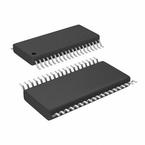● General:
● Supply voltage range from 1.9 V up to 3.6 V
● Operating temperature range from -40 to +85 °C
● Low power down current consumption
● Advanced power control system for lowest system current consumption, switching the microcontroller ortransmitter part into POWER DOWN or IDLE state whenever possible
● PG-TSSOP-38 package
● Transmitter:
● Multiband RF Transmitter for ISM frequency band 315/434/868/915 MHz
● SW configurable transmit power of 5/8/10 dBm into 50 Ohm load
● Selectable transmit data rates up to 32 kbit/s (64 kchips/s)
● RF Encoder supporting Manchester-, BiPhase- or NRZ coded data (Chip Mode)
● ASK/FSK modulation capability
● FSK frequency deviation up to 100 kHz
● Fully integrated VCO and PLL synthesizer
● Crystal oscillator tuning on chip
● Microcontroller:
● 8051 instruction set compatible microcontroller (cycle-optimized)
● 6 kbyte free programmable FLASH code memory
● 2 blocks of 128 byte FLASH data memory, alternatively usable as 31 byte emulated EEPROM
● ROM embedded software function library with preprogrammed functions and high level commands for easy programming
● 128 bit AES (Advanced Encryption Standard) embedded as software function
● 256 bytes RAM (128 bytes configurable to keep content in POWER DOWN state)
● 16 bytes XData memory (supplied in POWER DOWN state)
● 2 MIPS when using internal 12 MHz RC HF oscillator
● Peripherals:
● 125 kHz ASK LF Receiver
● LF Receiver data rate for typical 3.9 kbit/s (Manchester/BiPhase coded)
● 10 bit ADC with 3 pair differential channels and flexible high-gain settings (e.g. as inputs for external sensors)
● 10 free programmable bidirectional General Purpose Input Output pins (GPIO) with on-chip pull-up/pull-down resistors. 8 of them have wake-up functionality
● On-chip temperature sensor
● On-chip voltage sensor for low battery voltage measurement
● Brownout Detector
● Manchester/BiPhase Encoder and Decoder
● 16 bit hardware CRC Generator
● 8 bit Pseudo Random Number Generator
● I2C bus interface
● SPI bus interface
● Miscellaneous:
● Watchdog Timer
● 4 independent 16 bit timers
● Wake-up from POWER DOWN state possible by different sources: Interval Timer, Watchdog Timer, LF Receiver or external wake-up sources connected to GPIOs
● On-chip debugging via I2C interface
● 48 bit unique-ID on chip


